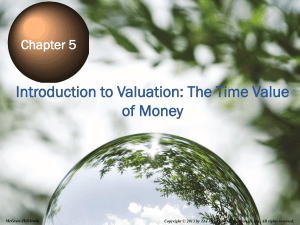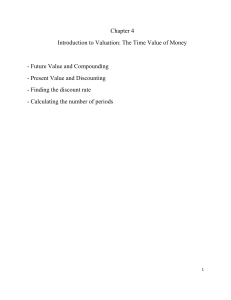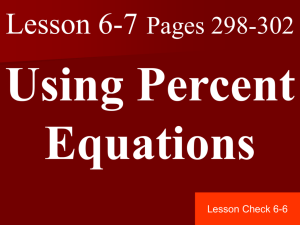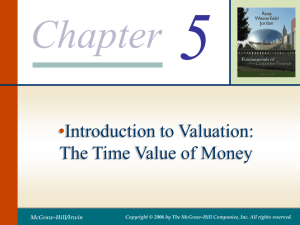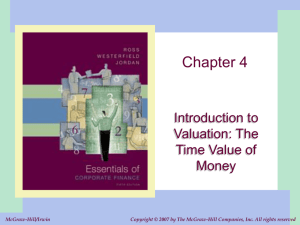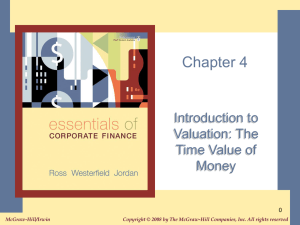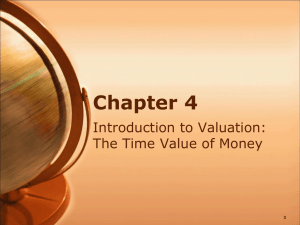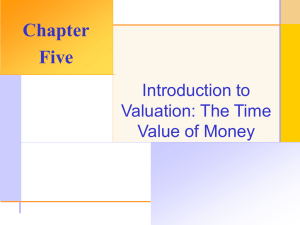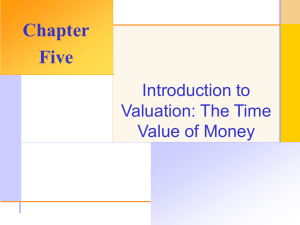Introduction to Valuation: The Time Value of Money
advertisement
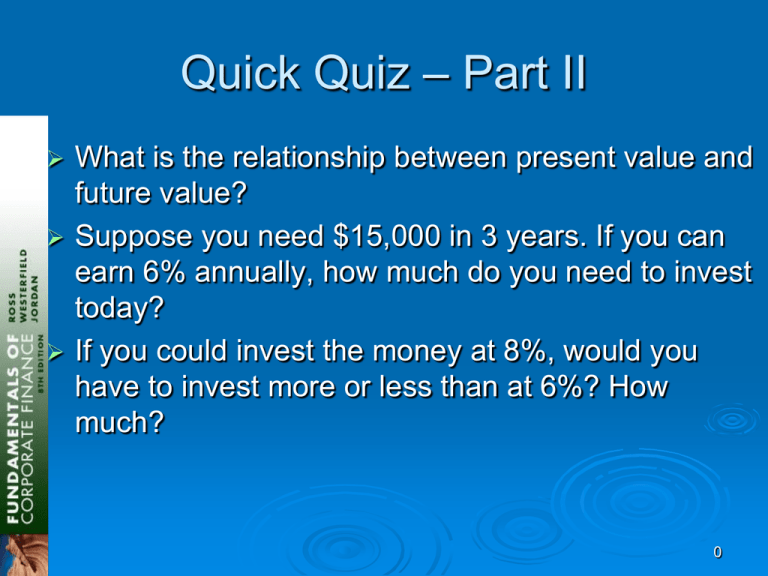
Quick Quiz – Part II What is the relationship between present value and future value? Suppose you need $15,000 in 3 years. If you can earn 6% annually, how much do you need to invest today? If you could invest the money at 8%, would you have to invest more or less than at 6%? How much? 0 The Basic PV Equation - Refresher PV = FV / (1 + r)t There are four parts to this equation PV, FV, r and t If we know any three, we can solve for the fourth If you are using a financial calculator, be sure and remember the sign convention or you will receive an error (or a nonsense answer) when solving for r or t 1 Discount Rate Often we will want to know what the implied interest rate is in an investment Rearrange the basic PV equation and solve for r FV = PV(1 + r)t r = (FV / PV)1/t – 1 If you are using formulas, you will want to make use of both the yx and the 1/x keys 2 Discount Rate – Example 1 You are looking at an investment that will pay $1,200 in 5 years if you invest $1,000 today. What is the implied rate of interest? r = (1,200 / 1,000)1/5 – 1 = .03714 = 3.714% Calculator – the sign convention matters!!! • • • • N=5 PV = -1,000 (you pay 1,000 today) FV = 1,200 (you receive 1,200 in 5 years) CPT I/Y = 3.714% 3 Discount Rate – Example 2 Suppose you are offered an investment that will allow you to double your money in 6 years. You have $10,000 to invest. What is the implied rate of interest? r = (20,000 / 10,000)1/6 – 1 = .122462 = 12.25% 4 Discount Rate – Example 3 Suppose you have a 1-year old son and you want to provide $75,000 in 17 years towards his college education. You currently have $5,000 to invest. What interest rate must you earn to have the $75,000 when you need it? r = (75,000 / 5,000)1/17 – 1 = .172688 = 17.27% 5 Quick Quiz – Part III What are some situations in which you might want to know the implied interest rate? You are offered the following investments: You can invest $500 today and receive $600 in 5 years. The investment is considered low risk. You can invest the $500 in a bank account paying 4%. What is the implied interest rate for the first choice and which investment should you choose? 6 Finding the Number of Periods Start with basic equation and solve for t (remember your logs) FV = PV(1 + r)t t = ln(FV / PV) / ln(1 + r) You can use the financial keys on the calculator as well; just remember the sign convention. 7 Number of Periods – Example 1 You want to purchase a new car and you are willing to pay $20,000. If you can invest at 10% per year and you currently have $15,000, how long will it be before you have enough money to pay cash for the car? t = ln(20,000 / 15,000) / ln(1.1) = 3.02 years 8 Number of Periods – Example 2 Suppose you want to buy a new house. You currently have $15,000 and you figure you need to have a 10% down payment plus an additional 5% of the loan amount for closing costs. Assume the type of house you want will cost about $150,000 and you can earn 7.5% per year, how long will it be before you have enough money for the down payment and closing costs? 9 Number of Periods – Example 2 Continued How much do you need to have in the future? Down payment = .1(150,000) = 15,000 Closing costs = .05(150,000 – 15,000) = 6,750 Total needed = 15,000 + 6,750 = 21,750 Compute the number of periods Using the formula t = ln(21,750 / 15,000) / ln(1.075) = 5.14 years Per a financial calculator: PV = -15,000, FV = 21,750, I/Y = 7.5, CPT N = 5.14 years 10 Quick Quiz – Part IV When might you want to compute the number of periods? Suppose you want to buy some new furniture for your family room. You currently have $500 and the furniture you want costs $600. If you can earn 6%, how long will you have to wait if you don’t add any additional money? 11 Spreadsheet Example Use the following formulas for TVM calculations FV(rate,nper,pmt,pv) PV(rate,nper,pmt,fv) RATE(nper,pmt,pv,fv) NPER(rate,pmt,pv,fv) The formula icon is very useful when you can’t remember the exact formula Click on the Excel icon to open a spreadsheet containing four different examples. 12 Work the Web Example Many financial calculators are available online Click on the web surfer to go to Investopedia’s web site and work the following example: You need $50,000 in 10 years. If you can earn 6% interest, how much do you need to invest today? You should get $27,919.74 13 Table 5.4 14 Comprehensive Problem You have $10,000 to invest for five years. How much additional interest will you earn if the investment provides a 5% annual return, when compared to a 4.5% annual return? How long will it take your $10,000 to double in value if it earns 5% annually? What annual rate has been earned if $1,000 grows into $4,000 in 20 years? 15

